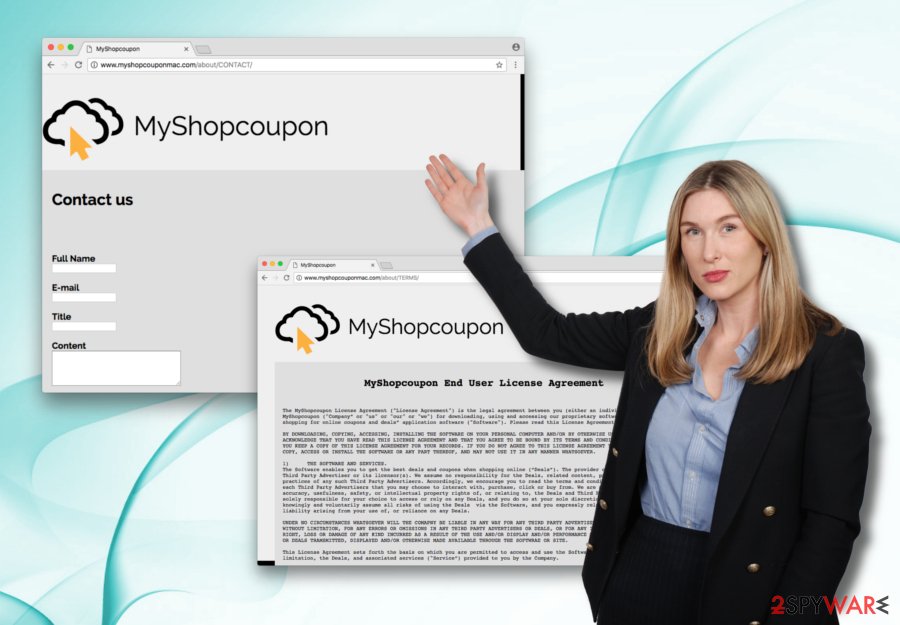MyShopcoupon (Removal Guide) - Jan 2021 update
MyShopcoupon Removal Guide
What is MyShopcoupon?
MyShopcoupon is a potentially unwanted application designed for Mac users

MyShopcoupon is adware application that has been bugging macOS users for a while now. The potentially unwanted app usually enters devices with the help of software bundling and performs certain changes to Safari, Google Chrome, Mozilla Firefox or Internet Explorer web browsers in order to display pop-ups, banners, offers, deals, and similar content. Additionally, some users might install this or any similar program like MyCouponsmart with the hopes of receiving some great deals for their online shopping. However, they soon notice that the ads become aggressive and intrusive, and pop whether users want it or not. For that reason, MyShopcoupon is an undesired application that should not be kept on macOS.
| Summary | |
| Name | MyShopcoupon |
| Type | Adware/PUP |
| Compatible with | macOS, iOS |
| Infiltration | Software bundling |
| Symptoms | Intrusive pop-up ads and redirects to questionable sites |
| Main dangers | Malware infections, personal data leakage |
| Elimination | Use our guide below and then scan your Mac using FortectIntego |
Adware programs can be potentially harmful as they can track your searches and fill your search results with sponsored links.[1] So, there is no doubt that MyShopcoupon removal should be your concern, especially if this program got into your system undetected.
At first glance, MyShopcoupon might seem like a legit application for Google Chrome, Mozilla Firefox, Safari or similar browsers, helping you to find shopping deals online. It promises a great variety of seemingly-useful functions:
- Free coupons and sales popping directly into the browser;
- Sales agents that show notifications for limited time offers;
- Personalized ads.
No matter that MyShopcoupon virus does exactly what it promises, it can also initiate additional activities behind your back. Consequences of these activities are negative in most of the cases because you can be fooled into visiting malicious websites or install dubious applications that would clutter your macOS.

Besides, MyShopcoupon ads can start interrupting you each time you start your search sessions. If you are not interested in coupons, banners, offers, deals, etc., these ads can seriously decrease your browsing quality.
Additionally, pop-ups caused by MyShopcoupon add-on might not only promote third parties but can also cause fake updates or alerts on your computer’s desktop. Falling for such ads is NOT recommended as obtaining malware is just a few steps away.
If you think about yourself as an inexperienced user, you can remove MyShopcoupon with only one click by using reliable security software (such as FortectIntego). Make sure you update the scanner before checking your computer for this virus.
If you decided to keep this PUP on your computer, keep in mind that MyShopcoupon collects various personal and non-personally identifiable information about its users. It is clearly stated in the Privacy Policy of this extension:
We may collect some personal information that you explicitly provide <…> and which identifies you personally, such as your name, email address, services purchased, etc. (“Personal Information”).
We also collect some non-identifying information regarding your use of our the Software, Services and Site, including but not limited to, type of device on which Software is used and installed, applications with which the Software has interacted, advertisements viewed <…>
Therefore, the consequences of such activities might be severe and could lead you to identity theft or stolen logins and passwords.
To sum up, MyShopcoupon is not dangerous on its own, but, as you can see, it can lead to a variety of negative outcomes. Therefore, you should uninstall this adware from your machine to stop MyShopcoupon ads from plaguing your browsers.

You can protect yourself from unwanted programs by monitoring installation of the freeware
This adware has been actively spread via bundling. Keep in mind that all programs that are promoted via software bundles get installed simultaneously.[2] If the user does not pay attention to the installation process, additional programs get a chance to infiltrate the machine without being noticed.
To protect yourself, in the very beginning of every freeware installation, please make sure you use Advanced/Custom settings instead of Recommended/Quick ones. This way you can defend yourself from unwanted programs easier. Additionally, do not try to simplify this procedure and read the information provided in every installation window. You should eliminate all check marks next to add-ons, screensavers, software uninstallers, PDF creators, and other crapware.[3]
You should also restrain yourself from clicking on suspicious ads and pop-ups on illegal websites (such as pornographic, gambling, online dating, etc.).
Uninstall MyShopcoupon from your computer
To remove MyShopcoupon effortlessly, you should thoroughly scan your Mac or Windows OS with reliable anti-malware software. At the moment, this extension is compatible with macOS/iOS only, but, if successful, the Windows/Android versions might be added as well.
However, if you do not wish to install additional software on your machine, we would like to suggest you proceed with manual MyShopcoupon removal. Our experts[4] have prepared a professional guide for you that carefully explains every step needed to get rid of this adware. Please, follow each of these steps carefully.
Right after you get rid of adware, your system’s performance will improve significantly, as well as internet browsing will become effortless again.
You may remove virus damage with a help of FortectIntego. SpyHunter 5Combo Cleaner and Malwarebytes are recommended to detect potentially unwanted programs and viruses with all their files and registry entries that are related to them.
Getting rid of MyShopcoupon. Follow these steps
Delete from macOS
To uninstall MyShopcoupon adware from macOS, use the following guide. We highly recommend uninstalling every suspicious entry that appears in the list.
Remove items from Applications folder:
- From the menu bar, select Go > Applications.
- In the Applications folder, look for all related entries.
- Click on the app and drag it to Trash (or right-click and pick Move to Trash)

To fully remove an unwanted app, you need to access Application Support, LaunchAgents, and LaunchDaemons folders and delete relevant files:
- Select Go > Go to Folder.
- Enter /Library/Application Support and click Go or press Enter.
- In the Application Support folder, look for any dubious entries and then delete them.
- Now enter /Library/LaunchAgents and /Library/LaunchDaemons folders the same way and terminate all the related .plist files.

Remove from Microsoft Edge
Delete unwanted extensions from MS Edge:
- Select Menu (three horizontal dots at the top-right of the browser window) and pick Extensions.
- From the list, pick the extension and click on the Gear icon.
- Click on Uninstall at the bottom.

Clear cookies and other browser data:
- Click on the Menu (three horizontal dots at the top-right of the browser window) and select Privacy & security.
- Under Clear browsing data, pick Choose what to clear.
- Select everything (apart from passwords, although you might want to include Media licenses as well, if applicable) and click on Clear.

Restore new tab and homepage settings:
- Click the menu icon and choose Settings.
- Then find On startup section.
- Click Disable if you found any suspicious domain.
Reset MS Edge if the above steps did not work:
- Press on Ctrl + Shift + Esc to open Task Manager.
- Click on More details arrow at the bottom of the window.
- Select Details tab.
- Now scroll down and locate every entry with Microsoft Edge name in it. Right-click on each of them and select End Task to stop MS Edge from running.

If this solution failed to help you, you need to use an advanced Edge reset method. Note that you need to backup your data before proceeding.
- Find the following folder on your computer: C:\\Users\\%username%\\AppData\\Local\\Packages\\Microsoft.MicrosoftEdge_8wekyb3d8bbwe.
- Press Ctrl + A on your keyboard to select all folders.
- Right-click on them and pick Delete

- Now right-click on the Start button and pick Windows PowerShell (Admin).
- When the new window opens, copy and paste the following command, and then press Enter:
Get-AppXPackage -AllUsers -Name Microsoft.MicrosoftEdge | Foreach {Add-AppxPackage -DisableDevelopmentMode -Register “$($_.InstallLocation)\\AppXManifest.xml” -Verbose

Instructions for Chromium-based Edge
Delete extensions from MS Edge (Chromium):
- Open Edge and click select Settings > Extensions.
- Delete unwanted extensions by clicking Remove.

Clear cache and site data:
- Click on Menu and go to Settings.
- Select Privacy, search and services.
- Under Clear browsing data, pick Choose what to clear.
- Under Time range, pick All time.
- Select Clear now.

Reset Chromium-based MS Edge:
- Click on Menu and select Settings.
- On the left side, pick Reset settings.
- Select Restore settings to their default values.
- Confirm with Reset.

Remove from Mozilla Firefox (FF)
Remove dangerous extensions:
- Open Mozilla Firefox browser and click on the Menu (three horizontal lines at the top-right of the window).
- Select Add-ons.
- In here, select unwanted plugin and click Remove.

Reset the homepage:
- Click three horizontal lines at the top right corner to open the menu.
- Choose Options.
- Under Home options, enter your preferred site that will open every time you newly open the Mozilla Firefox.
Clear cookies and site data:
- Click Menu and pick Settings.
- Go to Privacy & Security section.
- Scroll down to locate Cookies and Site Data.
- Click on Clear Data…
- Select Cookies and Site Data, as well as Cached Web Content and press Clear.

Reset Mozilla Firefox
If clearing the browser as explained above did not help, reset Mozilla Firefox:
- Open Mozilla Firefox browser and click the Menu.
- Go to Help and then choose Troubleshooting Information.

- Under Give Firefox a tune up section, click on Refresh Firefox…
- Once the pop-up shows up, confirm the action by pressing on Refresh Firefox.

Remove from Google Chrome
To fix Google Chrome, you need to reset it to its previous state by using these steps that are shown below.
Delete malicious extensions from Google Chrome:
- Open Google Chrome, click on the Menu (three vertical dots at the top-right corner) and select More tools > Extensions.
- In the newly opened window, you will see all the installed extensions. Uninstall all the suspicious plugins that might be related to the unwanted program by clicking Remove.

Clear cache and web data from Chrome:
- Click on Menu and pick Settings.
- Under Privacy and security, select Clear browsing data.
- Select Browsing history, Cookies and other site data, as well as Cached images and files.
- Click Clear data.

Change your homepage:
- Click menu and choose Settings.
- Look for a suspicious site in the On startup section.
- Click on Open a specific or set of pages and click on three dots to find the Remove option.
Reset Google Chrome:
If the previous methods did not help you, reset Google Chrome to eliminate all the unwanted components:
- Click on Menu and select Settings.
- In the Settings, scroll down and click Advanced.
- Scroll down and locate Reset and clean up section.
- Now click Restore settings to their original defaults.
- Confirm with Reset settings.

Delete from Safari
Remove unwanted extensions from Safari:
- Click Safari > Preferences…
- In the new window, pick Extensions.
- Select the unwanted extension and select Uninstall.

Clear cookies and other website data from Safari:
- Click Safari > Clear History…
- From the drop-down menu under Clear, pick all history.
- Confirm with Clear History.

Reset Safari if the above-mentioned steps did not help you:
- Click Safari > Preferences…
- Go to Advanced tab.
- Tick the Show Develop menu in menu bar.
- From the menu bar, click Develop, and then select Empty Caches.

After uninstalling this potentially unwanted program (PUP) and fixing each of your web browsers, we recommend you to scan your PC system with a reputable anti-spyware. This will help you to get rid of MyShopcoupon registry traces and will also identify related parasites or possible malware infections on your computer. For that you can use our top-rated malware remover: FortectIntego, SpyHunter 5Combo Cleaner or Malwarebytes.
How to prevent from getting adware
Stream videos without limitations, no matter where you are
There are multiple parties that could find out almost anything about you by checking your online activity. While this is highly unlikely, advertisers and tech companies are constantly tracking you online. The first step to privacy should be a secure browser that focuses on tracker reduction to a minimum.
Even if you employ a secure browser, you will not be able to access websites that are restricted due to local government laws or other reasons. In other words, you may not be able to stream Disney+ or US-based Netflix in some countries. To bypass these restrictions, you can employ a powerful Private Internet Access VPN, which provides dedicated servers for torrenting and streaming, not slowing you down in the process.
Data backups are important – recover your lost files
Ransomware is one of the biggest threats to personal data. Once it is executed on a machine, it launches a sophisticated encryption algorithm that locks all your files, although it does not destroy them. The most common misconception is that anti-malware software can return files to their previous states. This is not true, however, and data remains locked after the malicious payload is deleted.
While regular data backups are the only secure method to recover your files after a ransomware attack, tools such as Data Recovery Pro can also be effective and restore at least some of your lost data.
- ^ Removing Adware: What are the Risks?. Kaspersky Lab blog.
- ^ Lowell Heddings. Yes, Every Freeware Download Site is Serving Crapware (Here’s the Proof). How to Geek blog.
- ^ Adrian Kingsley-Hughes. Crapware: Why manufacturers install it, what you can do about it, and why it's not going to go away. ZDNet. News Network.
- ^ German security website Dieviren. Dieviren.




















